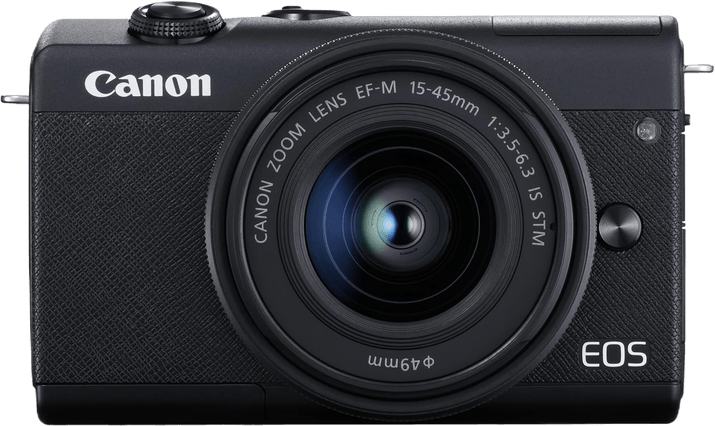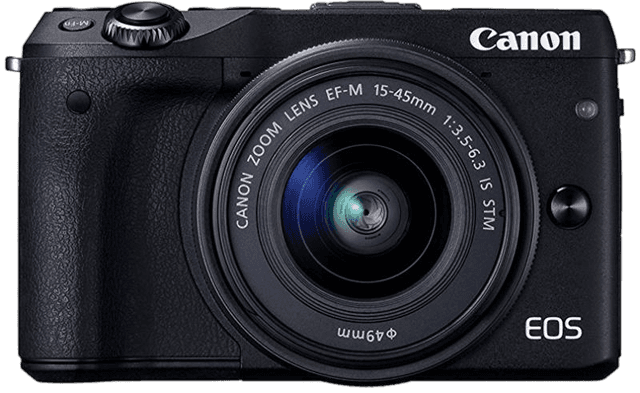Canon EOS M200 vs EOS M3 Comparison
Canon EOS M200

Canon EOS M3

The Canon EOS M200 emerges as the winner in this comparison, scoring 59/100, while the Canon EOS M3 trails slightly behind with a score of 56/100. Both cameras are mirrorless and were released in 2019 and 2015, respectively. They share some common features, but there are key differences that contribute to the M200’s higher score.
The M200 is a better camera due to its smaller size (108 x 67 x 35mm) and lighter weight (229g), making it more portable and convenient for everyday use. Additionally, the M200 has a lower launch price of $599 compared to the M3’s $870, offering better value for money.
On the other hand, the M3 has a slightly larger body (111 x 68 x 44mm) and heavier weight (366g), which may provide a more solid and stable feel for some users. However, this advantage is not significant enough to surpass the M200’s overall score.
Taking all factors into account, the Canon EOS M200 stands out as a better camera due to its smaller size, lighter weight, and more affordable price. The Canon EOS M3, despite its slightly more robust build, falls short in comparison.
Canon EOS M200 vs EOS M3 Overview and Optics
The Canon EOS M3 emerges as the winner in the optics comparison, with a score of 60/100, while the Canon EOS M200 scores 58/100. Both cameras share several specifications, including 24 megapixels, a CMOS sensor, an APS-C sensor size, a Canon EF-M lens mount, and a lack of image stabilization.
The EOS M3’s superiority in optics can be attributed to its marginally higher megapixel count of 24.2 and a significantly higher DXOMARK score for the sensor, at 72 compared to the M200’s 58. This suggests that the M3 has better image quality and improved low-light performance. Additionally, the M3 uses a Digic 6 processor, which, while older, is still capable of delivering good image quality.
On the other hand, the EOS M200 has a faster shooting speed of 6.1 frames per second (fps) compared to the M3’s 4.2 fps. This makes the M200 more suitable for capturing fast-moving subjects, such as sports and wildlife photography. Moreover, the M200 utilizes a more advanced Digic 8 processor, which can provide improved performance in certain aspects, such as noise reduction and autofocus.
While the EOS M3 has a slight edge in image quality and low-light performance, the EOS M200 offers better shooting speed and a more advanced processor. This means that the choice between these two cameras depends on the photographer’s priorities and the type of photography they are interested in. If image quality is the main concern, the M3 is the better option. However, if capturing fast-moving subjects is crucial, the M200 may be the preferred choice.
Canon EOS M200 vs EOS M3 Video Performance
The Canon EOS M200 emerges as the winner in terms of video capabilities, with a video score of 83/100, compared to the Canon EOS M3’s score of 43/100. This 40-point difference highlights the superior video features of the M200.
Both cameras share some common specifications. For instance, they both have a max video resolution and max video dimensions. However, the difference lies in the quality of these features. The EOS M200 boasts a 4K max video resolution and 3840 x 2160 max video dimensions, while the EOS M3 offers Full HD max video resolution and 1920 x 1080 max video dimensions.
The winning camera, the EOS M200, outperforms the EOS M3 in terms of max video frame rate as well. The M200 provides a 60fps max video frame rate, which is double the M3’s 30fps rate. This enables the M200 to capture smoother and more detailed footage. Additionally, the M200 has built-in time-lapse functionality, a feature absent in the M3. This allows users to create stunning time-lapse videos without requiring additional equipment or software.
Despite its lower video score, the EOS M3 may still be suitable for users who prioritize other aspects of photography and do not require advanced video features. However, it does not excel in any video-related areas compared to the M200.
Taking into account the specifications and features, the Canon EOS M200 is clearly the superior choice for users seeking advanced video capabilities. The higher video score, 4K resolution, greater max video dimensions, faster video frame rate, and built-in time-lapse functionality make the M200 a more versatile and powerful option for videographers. On the other hand, the EOS M3 may suffice for those with less demanding video requirements but falls short in comparison to the M200.
Canon EOS M200 vs EOS M3 Features and Benefits
The Canon EOS M200 emerges as the winner in the feature comparison with a score of 70/100, while the Canon EOS M3 trails behind at 57/100. Both cameras share several specifications, such as a 3-inch screen size, 1040000-dot screen resolution, touchscreen, flip screen, WiFi connectivity, and the absence of GPS.
The EOS M200 excels primarily due to its Bluetooth connectivity, which the EOS M3 lacks. This feature allows for easier and more convenient file transfers and remote control capabilities, enhancing the overall user experience. Additionally, the higher feature score of the EOS M200 signifies a more comprehensive set of features, contributing to its superiority over the EOS M3.
On the other hand, the EOS M3’s lower score does not necessarily mean it is inferior in every aspect. Both cameras share many common features, making the EOS M3 a viable option for users who do not require Bluetooth connectivity. The EOS M3 still offers a quality touchscreen, flip screen, and WiFi connectivity, which are essential features for modern-day photography.
In comparing the Canon EOS M200 and EOS M3, the M200 comes out on top due to its additional Bluetooth connectivity and higher feature score. However, the EOS M3 remains a suitable option for those who do not require Bluetooth and prioritize the shared features between the two cameras. Ultimately, the decision depends on individual preferences and specific needs.
Canon EOS M200 vs EOS M3 Storage and Battery
The Canon EOS M200 outperforms the Canon EOS M3 in storage and battery with a score of 21/100 compared to the M3’s 16/100. Both cameras share similarities in storage, featuring one memory card slot and accepting SD, SDHC, and SDXC cards. However, the M200 is UHS-I compatible, offering faster data transfer rates.
The M200’s battery life extends to 315 shots, surpassing the M3’s 250 shots per charge. Both cameras use different battery types, with the M200 using an LP-E12 and the M3 using an LP-E17. Neither camera supports USB charging.
Despite the M3’s lower score, it still offers adequate storage and battery life for casual photographers. However, the M200’s superior battery life and UHS-I compatibility make it the better choice for extended use and faster performance.
Canon EOS M200 vs EOS M3 – Our Verdict
Are you still undecided about which camera is right for you? Have a look at these popular comparisons that feature the Canon EOS M200 or the Canon EOS M3:

